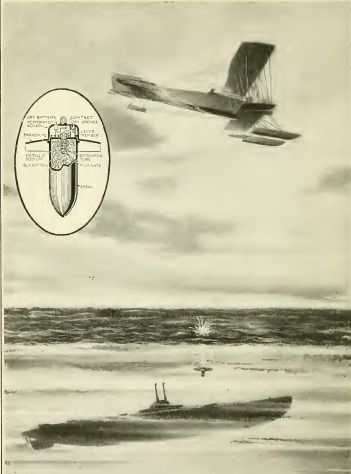Aerial torpedo
Contenuto
-
Titolo
-
Aerial torpedo
-
Article Title and/or Image Caption
-
Title: Torpedoing a submarine from an aeroplane
-
Title: The airman is monarch of all he surveys including the enemy submarine submerged thirty to forty feet under the water which is perfectly visible to him. He releases a bomb which is guided in its descent to the water and its speed under the water by the parachute, which is a dished circular plate. Two means are used to explode the bomb. Water flowing in through perforations either fires a quantity of sodium which in turn discharges the fulminate, or it completes the circuit of an electrical igniting apparatus setting off the bomb
-
extracted text
-
BECAUSE an airman flying above the
water can sight an underwater craft
and detect its approximate depth |
with the naked eye, inventors have de-
vised a number of bomb-dropping con-
trivances in an endeavor to make the
most of this strategic advantage and
place the submarine at the mercy of the
aeroplane. One of the most recent of
these devices is an aerial torpedo or
bomb containing high explosive which
when dropped from the acroplane makes
a vapid ang straight descent beneath the
water and explodes at the proper depth
and proximity to wreck a submarine. |
The bomb consists of a shell filled
with high explosive-and into ts closed
end is a detonator which consists
of a tube containing a layer of metallic
sodium, a layer of gun cotton and a
layer of ordinary fulminate. Attached
to the shell is a parachute, which is
nothing but a dished circular plate.
This acts as a guide in the descent of the |
bomb from the aeroplane to the water |
and also regulates the speed of the bomb
once it is under water, allowing it to
sink slowly.
The cover of the bomb as well as the
cap of the detonator-tube are perforated. |
When the bomb has sunk to a certain
distance, water flowing in through these
perforations ignites the sodium (a prop-
erty of sodium), which fires the gun.
cotton, which discharges the fulminate, |
which sets off the bomb. These different |
stages leading up to the actual explosion
occur nearly simultaneously, but should |
they fail—dnat is, shoukd the unforeseen
happen and the sodium not ignite, an |
electrical igniting mechanism is provided
which will discharge the fulminate.
Within the shell there is a dry battery
connected to a contact point and to one
end of a platinum glow wire embedded
in the fulminate, The other end of the
glow wire is connected to an insulating
lever carrying a contact point. This
fever member is a closed hollow tube
containing a little mercury, which, flow-
ing to the lower end, tends to kecp the
lever down. A tube in the perforated
cover contains a bucket filled with a dry
sponge.
"When once the bomb has struck the
water and the sponge has sufficiently
absorbed it, its weight bearing on the
end of the lever member raises this lever
into contact with the terminal, thus
completing the circuit and discharging
the fulminate.
There are several very obvious objec-
tions to a bomb of the type described.
It is very difficult to hit an object on
the ground when the aeroplane is very
high. Indeed, no satisfactory instru-
ment has thus far been invented to drop
bombs from great heights with anything
like the precision that marks the firing
of projectiles from great guns. If the
aeroplane is to destroy a submarine in
the manner proposed, the bomb-dropper
must be very near its target—so near
that it would itself be in danger from
gun fire. g
Some of the difficulties of dropping
bombs accurately spring from the fact
that an aeroplane moves through the
air at a rate of at least forty-five miles an
hour. + Allowance must be made not
only for that forward movement, but
also for the movement of the submarine
as well as for the wind. A hit would
therefore be almost a matter of luck.
-
Lingua
-
eng
-
Data di rilascio
-
1916-09
-
pagine
-
323
-
Diritti
-
Public domain
-
Archived by
-
Filippo Valle


